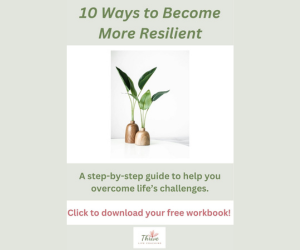Did you know that teaching is one of the most stressful careers?
If you’re a teacher, you’re probably not one bit surprised by this. We are constantly bombarded by increased demands on our time and attention, from new policies to follow, curriculum to implement, parent emails to respond to, meetings to attend, paperwork to fill out, and the list goes on. Not to mention all of the daily tasks of lesson planning, grading, prepping materials, addressing student behaviourissues, documenting, and actually teaching. It’s no wonder we’re overwhelmed.
When we’re in a chronic state of physical, mental, and emotional overload, it’s difficult to concentrate, make decisions, stay calm, feel rested, or feel accomplished. And this can lead to both physical and mental health issues as well as impact our relationships and possibly reduce our effectiveness in the classroom.
So how do we overcome overwhelm?
Well, there’s no magic bullet, but I am going to share some practical strategies that can help.
● Set boundaries:
Learn how to say no to optional tasks or activities, both at school and at home, that stretch you too thin. It can also be helpful to set a clear start and end time to do work-related tasks instead of working until you feel like the work is done because, honestly, a teacher’s work is never really done, am I right?
Setting boundaries is crucial to preserving your time, energy, and mental well-being. Start by identifying tasks and commitments that are essential versus those that stretch you too thin. Learn to say no to optional responsibilities, whether that’s taking on extra committees, staying late for unpaid work, or answering emails at all hours.
One effective boundary-setting strategy is establishing clear work hours. Set a start and end time for grading, planning, and answering emails—and stick to it. Avoid the trap of “just one more task” because, in teaching, the work is never truly done. Use tools like email autoresponders to communicate when you’ll be available and hold yourself accountable for respecting your own time.
● Prioritise and plan:
Choose to do only the things that have the greatest impact and stick to those. Finding an organization tool that works for you such as a planner or app can help you plan and stay
organized as well.
Not all tasks hold the same weight, so focus on what has the greatest impact. Instead of trying to do everything, narrow your focus to high-value activities that directly benefit student learning and your overall well-being.
Use the Eisenhower Matrix to help determine your priorities:
- Urgent & Important: Handle these tasks first (e.g., preparing for an observation, addressing a serious student issue).
- Important but Not Urgent: Schedule these (e.g., long-term curriculum planning, professional development).
- Urgent but Not Important: Delegate these when possible (e.g., administrative tasks).
- Neither Urgent nor Important: Eliminate or minimize these distractions (e.g., excessive lesson embellishments that don’t add value).
Find an organization system that works for you, whether it’s a planner, digital calendar, or task management app like Trello or Notion. Breaking tasks into manageable steps and setting deadlines can help reduce stress and improve efficiency.
● Delegate and simplify:
Teachers make countless daily decisions, so decide what things you can automate, delegate, or even get rid of to simplify the amount of things that demand your time and attention.
To prevent exhaustion, identify areas where you can delegate, automate, or simplify your workload.
- Leverage student responsibility: Assign classroom jobs (e.g., distributing materials, tracking homework submissions, updating bulletin boards). Not only does this lighten your load, but it also empowers students.
- Use technology to automate tasks: Tools like Google Forms can streamline assignments, self-grading quizzes, and surveys, reducing administrative work.
- Cut the clutter: If a lesson or activity isn’t significantly improving student engagement or learning outcomes, consider simplifying or eliminating it.
By making strategic decisions about what to keep, delegate, or eliminate, you create space for what truly matters.
● Pitch perfection:
Stop trying to do everything perfectly. Have you ever spent hours crafting the perfect learning activity, only for it to fall flat with your students? Or spent the weekend at school creating a new bulletin board they barely noticed? Try letting go of the idea that every lesson has to be perfect or that you need to have a Pinterest-perfect classroom because, honestly, when is it ever good enough for you to be satisfied? Probably never. So give yourself a break and allow yourself to be “good” or even just “fine” because perfection is a goal that no one can ever reach, and we just exhaust ourselves trying.
Perfectionism is a hidden energy drain that can leave teachers feeling like their work is never good enough. While high standards are valuable, obsessing over flawless lesson plans, intricate bulletin boards, or perfectly curated resources can lead to unnecessary stress.
- Reframe success: Instead of aiming for perfection, ask yourself: “Is this effective? Is this helpful? Does it serve the students’ learning goals?”
- Adopt a “done is better than perfect” mindset: If you find yourself over-editing materials or spending excessive time tweaking lessons, remind yourself that a well-prepared but imperfect lesson can still be impactful.
- Let go of comparison: Avoid falling into the trap of comparing yourself to the Instagram or Pinterest version of teaching. Every classroom is unique, and students benefit more from a well-rested, engaged teacher than a picture-perfect environment.
● Take care of yourself:
Schedule non-negotiable time to take care of yourself, whether that be time for exercise, reading a book for pleasure, meeting up with friends, or engaging with a favourite hobby.
Self-care isn’t selfish—it’s essential. Teachers give so much to others, but you can’t pour from an empty cup. Prioritize your well-being by scheduling time for activities that rejuvenate you.
- Physical care: Engage in activities that keep your body moving, whether that’s yoga, walking, or even a 10-minute stretch between classes.
- Mental and emotional well-being: Carve out time for activities that bring you joy and relaxation—reading, crafting, listening to music, or even a simple cup of tea in silence.
- Rest and recovery: Create non-negotiable downtime in your schedule. Make sleep, breaks, and mindfulness practices a priority rather than an afterthought.
By taking care of yourself, you build the resilience needed to show up as your best self for your students.
● Get support:
Connect with other teachers, friends, or your partner who will support you in maintaining your overall well-being. Partnering with a therapist or coach can be very helpful as well.
No teacher should navigate the challenges of education alone. Building a strong support system can make a world of difference in managing stress and preventing burnout.
- Lean on fellow educators: Share struggles and strategies with colleagues who understand the challenges firsthand.
- Join teacher communities: Whether it’s an online group, union, or professional network, connecting with other educators can provide encouragement and shared resources.
- Seek professional guidance: Speaking with a therapist, coach, or mentor can help you develop coping mechanisms and maintain a healthier work-life balance.
If you’re feeling overwhelmed, remember: you don’t have to do it all alone. Seeking support is a strength, not a weakness.
Teaching is demanding, but it doesn’t have to come at the cost of your well-being. By implementing these strategies—setting boundaries, prioritizing, simplifying, letting go of perfection, practicing self-care, and seeking support—you can regain control, reduce overwhelm, and create a more sustainable, fulfilling career.
Because a happy, healthy teacher is the best gift you can give your students.
By implementing these strategies, you should start to feel more in control and able to respond to the things that overwhelm you rather than react to them, bringing more peace and calm to each day.
So, are you ready to overcome overwhelm, take back control of your life, and start truly thriving? There’s no better day than today to begin.







